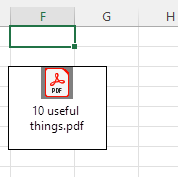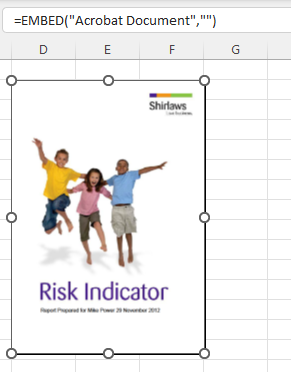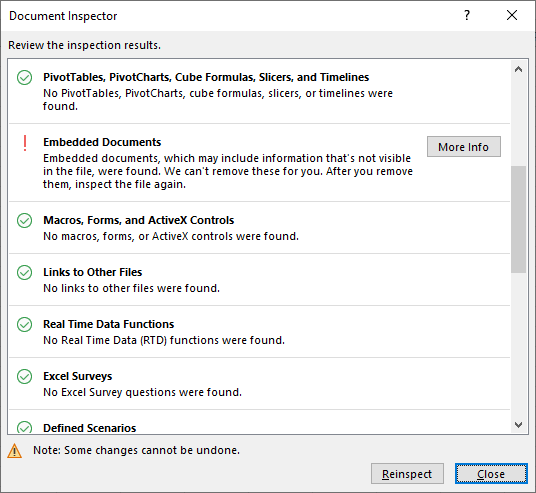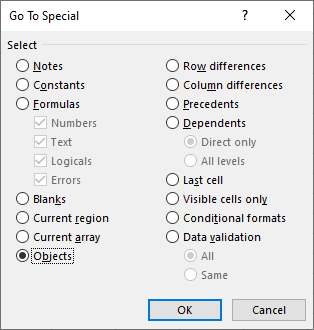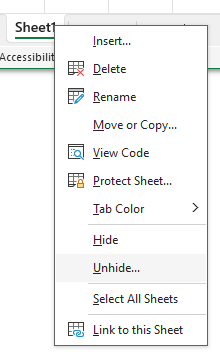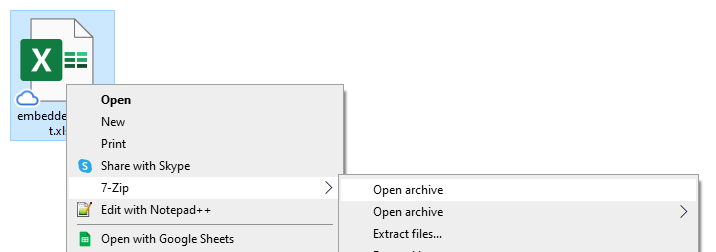How to find embedded objects in Excel
It’s possible to embed other documents into your Excel spreadsheets. Most commonly this will be done to attach supporting documents to a spreadsheet for further reference if needed.
It is a handy way to keep related information together, but it can increase file size significantly. Also because the files are often shown as icons you can’t see the full content of what you are sharing, so it can lead to accidentally sharing sensitive information.
It’s not always straightforward to find all the embedded objects in your Excel file just by looking. So today we are going to show you how to find any and all objects in your Workbook — and give you some tools and techniques for dealing with them.
What are embedded documents in Excel?
You can embed many types of objects inside a Microsoft Excel Workbook. Typically they will either be embedded as an icon, in which case it will look something like this with the icon for the application associated with that file type:
Or the embedded objects will look like pictures but if you click on them you will see =EMBED(“file type”) in the formula bar as you can see in this picture below. This is useful when you want to show the content of the file e.g. the first page of a PDF document. In this case you will have the object embedded in the file and also a separate picture representation that Excel has created for display in the spreadsheet - usually an EMF (Enhanced Metafile) file.
Creating embedded objects with picture representations can sometimes happen by accident, for example, when you copy and paste a picture into Excel from another application.
Why might you need to find embedded objects in Excel?
If you run Excel’s Document Inspector you may find that it warns you that embedded documents were found and that they may include information not visible in the file. But it doesn’t tell you where to find them in the Workbook so you can check they don’t contain anything sensitive.
The main reasons for finding embedded objects in Excel are:
Avoid sharing sensitive information: embedded objects can contain large amounts of information that is not visible in the spreadsheet.
Reduce file size: embedded objects can significantly increase the size of an Excel file, and often this isn’t necessary.
Index references: a need to compile a list of all associated documents embedded in the main Excel workbook.
Whatever the reason, you probably want a more reliable approach than just searching through the document by eye, looking for anything that might possibly be an embedded object.
How to quickly find embedded objects in Excel
On Windows or Mac navigate to the Home tab of the ribbon near the right-hand side click the down arrow next to Find & Select then choose Go To Special…
This will open up the Go To Special dialog shown below.
Choose Objects from the Select list and then click OK.
Press Tab to cycle through the objects on your worksheet.
NOTE: This only works on the active sheet. To find all objects in a Workbook you will need to repeat the above on each sheet. Watch out for any hidden sheets - right-click on a sheet name tab and see if the Unhide… option is available.
If you are worried that embedded objects are making your Excel file too large, read on for instructions on how to be certain, and how to fix it.
Find the size of embedded objects in Excel
To check whether embedded objects are making your file large we recommend using 7-Zip, a free utility for Windows that can be used to look inside XLSX files. On Mac you can use BetterZip, or PeaZip. We’ve written a guide here on how to look inside Office files on Mac.
Once installed it will add some new options to your right-click menu — now you can right-click on the Excel file icon and choose 7-Zip > Open archive option.
If your embeddings folder is very large then you may need to edit the content to replace embedded objects with pictures, or other options. For more guidance on this check out our helpful article on how to reduce the size of Excel spreadsheets.
In this example, this 3mb file is virtually all accounted for by the embeddings folder as you can see highlighted below.
If your objects are the type that look like pictures, then in addition to the embeddings folder they will also be taking up space in the Media folder as well. As previously mentioned Excel will create the picture representations as .emf files.
Excel has helpful tools for tracking down specific content in your file. Hopefully now you’ll be able to easily find and manage any objects that find their way into your Excel workbooks, whether intentionally or by accident.
Compress embedded objects in Excel
Automatically compress embedded objects, and anything else that’s making your Excel files too large with our Excel Compressor app — NXPowerLite Desktop.
Should we make an Excel Add-in for this?
Can you let us know if you’d be interested in an Excel add-in that makes managing embedded objects and other media in your Excel files super easy. We have already built something similar for PowerPoint called Slidewise, and we’d love to know if a similar tool for Excel would be useful. It might look something like this:
Interested?
If you’d love to add Sheetwise to your toolbox — please share your email with us to let us know. We’ll also keep you notified of any progress.

